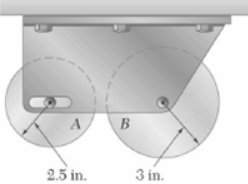Solve the below problem:
Q: A simple friction drive consists of two disks A and B. Initially, disk B has a clockwise angular velocity of 500 rpm, and disk A is at rest. It is known that disk B will coast to rest in 60s. However, rather than waiting until both disks are at rest to bring them together, disk A is given a constant angular acceleration of 3 rad/s2 counterclockwise. Determine
(a) At what time the disks can be brought together if they are not to slip,
(b) The angular velocity of each disk as contact is made.
